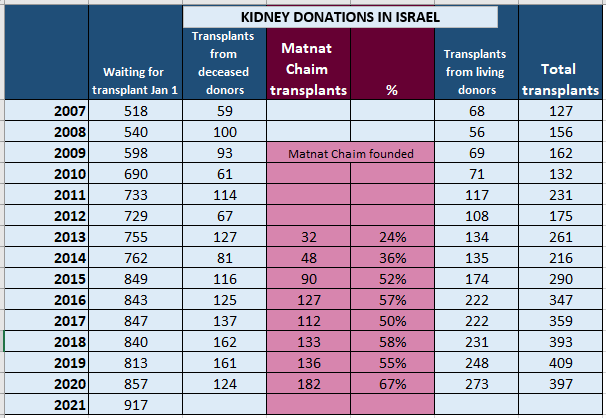
Conditional altruistic living-donor kidney donation in Israel and its impact on living-donor kidney transplant growth
Eytan Mor1, Tamar Hod1,2, Ronen Ghinea1, Angela Bar1, Judy Singer3.
1Transplant Center, Department of Surgery B, Sheba Medical Center, Ramat-Gan, Israel; 2Department of Nephrology, Sheba Medical Center, Ramat-Gan, Israel; 3Matnat Haim Organization, none, Jerusalem, Israel
Introduction: With a limited number of deceased organ donors in Israel, transplant tourism was often used as an alternative source for kidneys until the enactment of the Israel Transplant law in 2008 which severely limited that activity. In an effort to find a legitimate path for the supply of kidneys for transplant, the law approved altruistic donation and established a regulated central governmental mechanism to ensure an altruistic motivation for donation. A year later, in 2009, the Matnat Chaim organization started its initiative to promote altruistic donation within the Jewish sector according the highest imperative of saving another's life according to religious beliefs and social behaviour. Here, we report the results of that activity over the last 8 years.
Methods: We used Israel Transplant Centre database and the Matnat Chaim organization’s database reporting the transplant activity for the period of 2013-2021. We looked at the growth of deceased and living-donor kidney transplantation and the proportion of altruistic kidney donations out of the total number of living-donor transplants over that period. We also reviewed the donors’ pre-donation questionnaires to learn about their preferences regarding their paired recipients in terms of age, social sector and religious observance.
Results: Over the period studied, the number of kidney transplant candidates on the waiting list increased from 755 to 917 patients while the number of kidney transplants from deceased donors increased from 127 to 149 (excluding combined kidney-liver or kidney-pancreas transplants). The total number of live-donor transplantation increased from 261 to 476. The primary growth in the number of kidney transplants came from altruistic donations, with an increase from 32 to 215 donors a year (X6.7), and their proportion within the overall live donor total increased from 24 to 66% (figure 1). It should be noted that in many cases, Matnat Chaim was responsible for facilitating donation within the family after an initial interview of patients who approached the organization. Although in the majority of cases altruistic donors donated their kidney to a recipient within their community or religious group, on other occasions donors agreed to change the original directed allocation and donate their kidney within a paired exchange program (48 donors) or directly to a highly sensitized patient on the waiting list. However, for many of the altruistic donors, conditional donation was a prerequisite and had they not been allowed to donate within their community, they would not have donated a kidney at all.
Conclusions: Conditional altruistic donation within a community is a legitimate path with a major potential to increase organ donation. Unlike non-conditional donation where kidneys are allocated to the waiting list, our system of conditional altruistic donation may raise some ethical issues; however, we consider it a valid option on a scale between a family donation and altruistic non-directed donation.

The abstract is in memory of my friend Rabbi Yeshayahu Heber, the founder and chairman of Matnat Chaim. Rabbi Heber was a transplant recipient who died far before his time during the first wave of the COVID-19 pandemic, in April 2020. Over 1200 kidney recipients are alive today due to his vision and determination.

right-click to download
